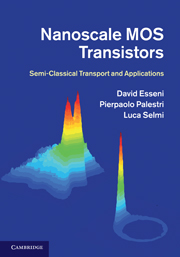Book contents
- Frontmatter
- Contents
- Preface
- Acknowledgements
- Terminology
- 1 Introduction
- 2 Bulk semiconductors and the semi-classical model
- 3 Quantum confined inversion layers
- 4 Carrier scattering in silicon MOS transistors
- 5 The Boltzmann transport equation
- 6 The Monte Carlo method for the Boltzmann transport equation
- 7 Simulation of bulk and SOI silicon MOSFETs
- 8 MOS transistors with arbitrary crystal orientation
- 9 MOS transistors with strained silicon channel
- 10 MOS transistors with alternative materials
- Appendices
- Index
4 - Carrier scattering in silicon MOS transistors
Published online by Cambridge University Press: 05 August 2011
- Frontmatter
- Contents
- Preface
- Acknowledgements
- Terminology
- 1 Introduction
- 2 Bulk semiconductors and the semi-classical model
- 3 Quantum confined inversion layers
- 4 Carrier scattering in silicon MOS transistors
- 5 The Boltzmann transport equation
- 6 The Monte Carlo method for the Boltzmann transport equation
- 7 Simulation of bulk and SOI silicon MOSFETs
- 8 MOS transistors with arbitrary crystal orientation
- 9 MOS transistors with strained silicon channel
- 10 MOS transistors with alternative materials
- Appendices
- Index
Summary
In Chapter 3 we discussed in detail determination of the energy levels and wave functions of a quasi-2D electron or hole gas at equilibrium. Consistent with the time independent Schrödinger equation used in our calculations, the electronic states are stationary states, in the sense that the carriers do not have transitions between the states and the lifetime of the states is infinitely long.
In real physical systems there are perturbations of the Hamiltonian used to calculate the band structure that can be collectively referred to as scattering mechanisms and that produce a very large number of electronic transitions per second between the available states.
If the system is driven out of equilibrium by an external stimulus, such as the source to drain electric field responsible for the drain current in a MOSFET, then the scattering mechanisms tend to restore the equilibrium. This latter statement means that, on the one hand, if the stimulus is removed at a given time, then the scattering events govern the transient of the system back to the equilibrium. On the other hand if, say, an electric field tends to accelerate the carriers and transfer energy to the carrier gas, then in a stationary transport condition an equilibrium is reached between the effects of the field and the relaxation of the momentum and energy produced by the scattering events. Such an equilibrium determines the stationary properties of the carrier gas subject to a constant electric field.
- Type
- Chapter
- Information
- Nanoscale MOS TransistorsSemi-Classical Transport and Applications, pp. 112 - 206Publisher: Cambridge University PressPrint publication year: 2011
- 2
- Cited by



